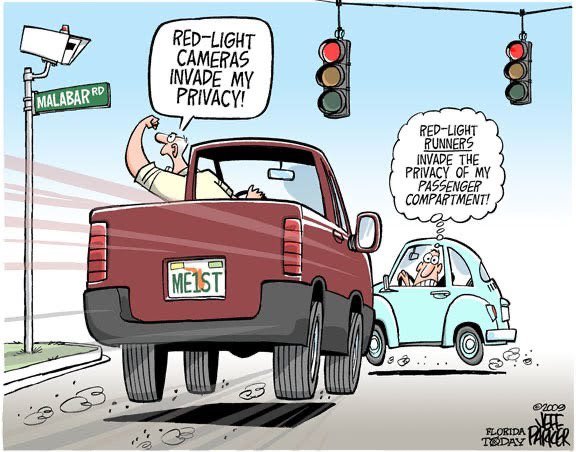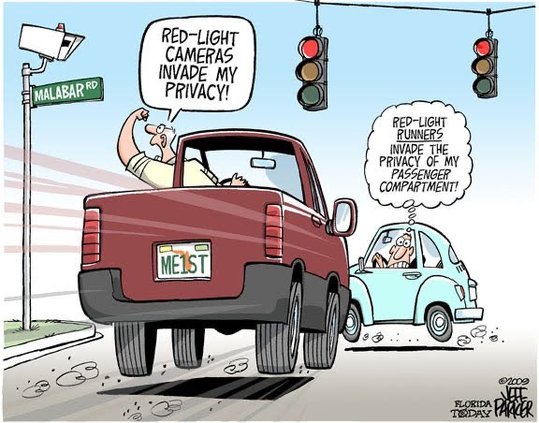The start of the email was short and to the point.
Red light cameras are unconstitutional.
The answer requires even less words.
No they are not.
The founders didn’t mince words.
Nor did they get down into the weeds.
The original federal constitution had 4,543 words.
With all of its amendments, it now stands at 7,591 words.
Compare that to California’s state constitution that has 32 articles, 350 sections and roughly 75,000 words.
California’s is a lightweight compared to the constitution for the State of Louisiana.
The state boasting “Union, Justice, and Confidence” as its motto has 184,053 words in its constitution.
The federal constitution was designed as a template.
It is not a step-by-step instruction sheet.
That means it addressed general basic concepts and not specific details.
The First Amendment does not convey the right to speed or run red lights.
The Fourth Amendment does touch upon unlawful searches and seizures.
One might argue a ticket issued with the use of technology is an unlawful and unreasonable search of either self or property — your car — but that is beyond a stretch.
The Tenth Amendment makes it clear that, among other things, that regulation of commerce and law enforcement activities within a state’s borders are within a state’s purview
And yes, the Ninth Amendment declares individuals have other fundamental rights not referenced in the Constitution.
The Supreme Court over the years has declared that among those unenumerated rights are the right to travel and the right to privacy.
Neither, like any other right, is carte blanche or absolute.
They are weighed against the rights of others.
It is why states have the right to regulate speed and impose other traffic regulations such as stopping at red lights.
As for privacy, it is far from absolute in public areas.
Technology used to catch an illegal act clearly seen from a public place such as the face of a driver running a red light is not an illegal or unconstitutional invasion of privacy.
Previous red light running technology that was dismissed as being “illegal” did not meet the high threshold of standards the State of California, as well as other states require.
The radar, video quality, and manner of evidence gathering of the red light cameras being deployed in Manteca and Tracy by American Traffic Solutions meets those standards.
Trained law enforcement officers still have to examine the evidence collected to make sure it clearly is a legal violation before a citation can be issued.
Red light cameras, per se, are not unconstitutional.
At the same time, there is no constitutional right to exceed lawfully posted speed limits or to run red lights.
Among other pushback against red light cameras is that it will simply encourage people to speed up when lights turn amber.
That is the problem to begin with.
Instead of making a decision to err on the side of caution, too many drivers at the point they see an amber light opt to “go for it” even when they clearly have ample time to safely come to a stop.
Traffic signals have delayed timing between when they turn red for one direction of travel before they turn green for another direction of travel.
California law covers what that is based on the posted speed limit.
The goal is to get people to drive safely.
That means not pushing, or exceeding, the envelope.
Red light cameras reduce the odds of accidents happening.
Hard data supports that conclusion.
Keep in mind, the evidence collected by technology and reviewed by a law enforcement officer needs to qualify as a clear cut violation.
Calibrated radars record the speed.
Various camera angles record the car’s position in relation to when the light turns amber and whether it broke the plane of the limit line — or front line of a crosswalk — before the high turns red.
The system, as such, allows the making of a legal right turn on a red light after coming to a complete stop and not impeding the safe path of a pedestrian or vehicle legally in the intersection.
The real rub, of course, is such systems take the odds of one being caught from running red light at intersection approaches equipped with such a camera system from almost 0 percent to almost 100 percent.
There is a surefire way not to get caught in a “technology dragnet” as one person decried.
No, it doesn’t involve some online gizmo to place in your car that somehow renders the red light technology ineffective as you run a red light.
The trick to beating the red light camera is to drive in a manner that avoids running red lights.
As things stand now with 80 plus signalized interactions, six traffic officers, other issues such as speeding and accidents plus other infractions on a 24/7 basis we do indeed have what former Manteca Mayor Ben Cantu succinctly referenced as “Wild West” conditions on city streets.
Previous deployments of the camera technology coming within a month to Manteca’s streets has led to what is dubbed “the halo effect.”
That means a large share of drivers not only stop running red lights at camera equipped intersections but also refrained from doing so elsewhere.
There was even an across the board drop in overall moving violations on the streets of cities with red light cameras.
Red light running is epidemic in Manteca.
In analyzing one intersection that will be getting cameras, there were 80 plus red light running incidents observed during a set period on one day..
That’s more than double the national rate for intersections that are problematic for red light running.
It should be noted the city is not likely to see much, if any, of the revenue generated from red light camera tickets.
American Traffic Solutions, however, will get money from the city’s cut which is between 17 and 25 percent of traffic fines assessed by the courts.
Rest assured, if red light running drops off substantially at some point in the future, American Traffic Solutions will not be renewing their contract with Manteca.
The firm is in it for the money.
Manteca is in it for the safety.
The bottom line: If you want red light cameras to go away, then stop running red lights.
This column is the opinion of editor, Dennis Wyatt, and does not necessarily represent the opinions of The Bulletin or 209 Multimedia. He can be reached at dwyatt@mantecabulletin.com





